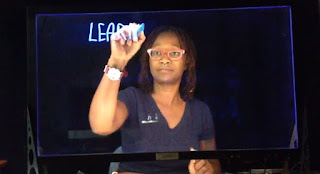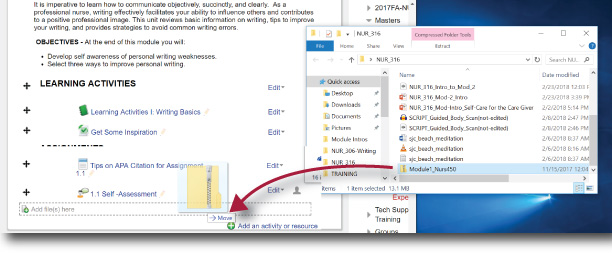Video Light Board
Educators across multiple disciplines will find video light boards useful in: illustrating problem-solving, annotating lectures, and sketching examples in real-time. This tool can save production time when you create educational videos. It’s located in the new Multimedia Studio in UAB 119.
Note: To gain access to this resource and the full studio, members of the campus community must take either the online training or attend an in-person training.
The Light Board Unit
Our light board was manufactured by Learning Glass™. The Learning Glass™ technology is deceptively simple: LED lighting on low-iron glass creates a transparent white board. With a neon marker in hand, the presenter faces the audience while writing on the board. This approach improves audience engagement in online presentations; as opposed to turning ones back on the camera/audience when using a traditional whiteboard in video. With the semi-transparent frosted glass insert in place, presenters annotate directly on the glass.Images are flipped in real time for streaming or live presentations through the reverse scan camera. No special skills (such as writing backwards) are needed to use the Learning Glass.
* excerpt from product description at Learning Glass website
Light Board Best Practices:
- Come in with a plan: does a light board video align with your learning outcomes; what will you cover in your video(s); and how might you design this video to be reusable beyond a single term or course.
- Light board video works best when it covers small chunks of content, clearly delineated problems, or specific calculations.
- If you must clean the board during your video, remember to edit out that “dead air time” before your video goes live.
- Dress appropriately: Steer clear of all black or white. Wearing dark colors will make your body fade into the background. Bright white will negatively affect the camera light balance.
- Avoid wearing clothes with text across the front as this text will appear in reverse in the video.
- Position yourself to the side, rather than the middle of the board. This will allow you more writing real estate.
A Pedagogical Approach to the Light Board
When considering using the light board we would ask that you consider some important questions:- Why is this tool appropriate for this video?
- Do online video resources already exist which might be available for you to address your teaching and learning problem?
- How might you create this video so that it is a reusable video resource?
- What do you want your students to learn while watching your video? If there are multiple learning objectives might we consider creating multiple videos?
- What approach is best suited to support that learning (i.e. a narrative, an explanation, an animation, etc.)?


